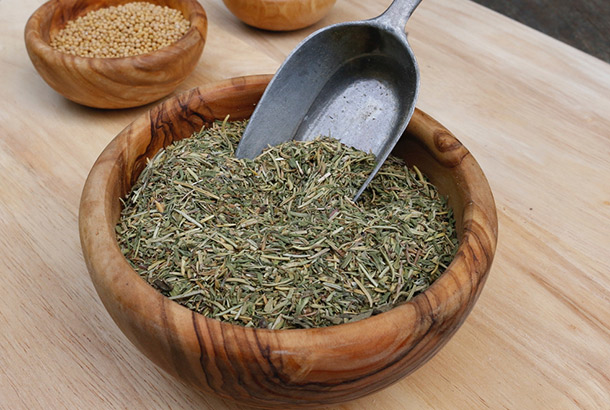This classic blend of herbs will become your go-to seasoning for everything from chicken to fish to soups and stews to roasted vegetables. Herbes de Provence can take a plain dish from basic to wow so easily you’ll want to put it on everything!
Here’s how to make herbes de Provence at home with just a few simple ingredients – including easy herbal substitutes you probably already have in your spice drawer.
What Is Herbes De Provence?
Herbes de Provence is a classic mixture of dried herbs typical of the south of France. I brought my first jar home from a trip to France years ago. The ingredients were thyme, rosemary, savory, marjoram, and basil.
Since then, I’ve been making my own Herbes de Provence blend. I mix it a little bit differently each time, and always keep the jar on the counter to flavor whatever I’m cooking.
And you may be surprised that you have everything you need to make your own French herb blend already in your pantry.
What Can I Use As A Substitute?
If you don’t have a jar of traditional herbes de Provence mix, don’t worry! You can make your own substitute blend with a few common herbs – like rosemary, thyme, and oregano. This recipe is so versatile, you can create a blend with whatever Mediterranean region herbs you have on hand.
Did you know your herbs and spices have a shelf life? Dried herbs will last one to three years, but will start to lose their flavor over time. Making herbes de Provence is a great way to use up all those half-full bottles of dried herbs in your spice rack.
What Herbs Are In Herbes De Provence?
The traditional herb mixture from the Provence region of France includes a combination of thyme, rosemary, savory, marjoram, and oregano. Other recipe variations include additional herbs like tarragon, fennel seeds, bay leaves or chervil.
The classic recipe by Julia Child for chicken with herbes de Provence from Mastering the Art of French Cooking includes basil, thyme or savory, and a pinch of fennel along with garlic to create the Provençal flavor (fresh herbs or dried herbs can be used).
For this easy homemade substitute, dried thyme and rosemary are required, and I always have them on hand. After that, I will add a combination of marjoram, basil, oregano, tarragon, parsley, or sage – depending on what I have in the kitchen.
If I don’t have summer savory or winter savory, thyme is the closest substitute. If I don’t have marjoram, I’ll substitute oregano since it’s similar in flavor.

Pro tip: Oregano works as a one-for-one substitute for marjoram in this herb mixture but in other recipes, you may want to use less oregano because it has a stronger flavor than marjoram.
While lavender is not included in the traditional French mixture, many herbes de Provence blends you find in grocery stores will include lavender buds or flowers. I’m not really a fan of using lavender in the mix. Skipping the lavender makes the blend more versatile – I will often use it in place of an Italian herbs blend since it has a similar flavor profile without the lavender.
The great thing about making your own herbs and spice blends is that you can add whatever you like. You really can’t go wrong. Just add your favorites, and adjust the proportions to your taste. Make as much or as little as you need.
Of course, if you don’t want to make your own blend, you can always buy a French blend with lavender or without lavender.
Once you have your favorite blend, keep it in an airtight container and store it in a dry place. You’ll find yourself using this spice mix on everything. It’s a great way to add flavor to healthy recipes that’s paleo, keto, and Whole30-friendly.
And it’s the best poultry seasoning substitute! I always put it on roast chicken and my Thanksgiving turkey. It’s wonderful on salmon and roasted root vegetables, eggplant or zucchini. And it’s a great way to add a little herb flavor to long-simmering soups and sauces.
Easy Recipes Using Herbes De Provence
The flavors of herbes de Provence work beautifully with other Mediterranean ingredients. Try it with garlic powder, olive oil, red peppers, or tomatoes in Italian cooking. Or simply combine it with sea salt and cracked black pepper to bring out the flavors of chicken, turkey, fish, or vegetables.

